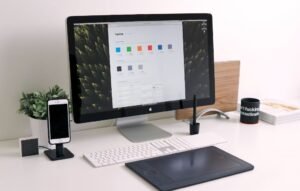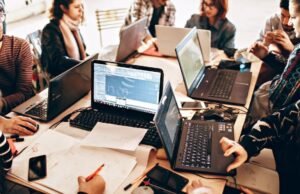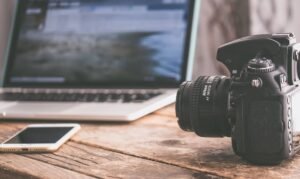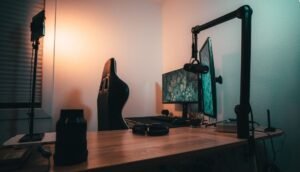Do AI Apps Steal Art?
Artificial Intelligence (AI) has revolutionized several industries, including art, by enabling the development of AI apps that can generate stunning visual content. However, concerns have been raised about the ethics of using AI in the creation of art and whether it infringes upon the rights of human artists. In this article, we delve into the question: do AI apps steal art?
Key Takeaways:
- AI apps use algorithms to generate visual art.
- AI-generated art may replicate existing artworks.
- Legal and ethical considerations are important when using AI in art creation.
- AI apps can also help support and inspire human artists.
- Collaboration between AI and human artists can lead to unique creations.
**AI apps use complex algorithms** to analyze vast amounts of data and generate visual art. These algorithms are trained on existing artworks, allowing the AI to understand and replicate certain art styles, techniques, and even specific artworks to some extent.
Using AI to create art raises questions regarding **originality and authorship**. While AI-generated art can be visually impressive, some argue that it lacks the depth and emotional expression of human-created art, ultimately devaluing the role of human artists.
**The legality of AI-generated art** is another aspect to consider. Copyright laws protect original artistic works, but when AI apps create derivative art that closely resembles existing works, it can be challenging to determine the line between inspiration and infringement.
One interesting development is the rise of **AI-generated art auctions**. Christie’s, a renowned auction house, sold an AI-generated artwork titled “Portrait of Edmond de Belamy” for $432,500 in 2018. This event sparked discussions about the value and legitimacy of AI art in the art market.
The Impact on Human Artists
Despite concerns, AI apps can actually **support and inspire human artists**, amplifying their creativity and expanding their artistic possibilities. For instance, artists can use AI-powered tools to experiment with different styles, generate ideas, and save time in the creation process.
Moreover, **collaboration** between human artists and AI can yield fascinating results. AI can assist by suggesting artistic elements, generating preliminary sketches, or even merging the styles of multiple artists into one cohesive piece. This collaborative approach allows for the creation of **unique and one-of-a-kind artworks**.
Data Points on AI Art
| Year | Artwork | Sale Price |
|---|---|---|
| 2019 | AI-generated artwork “Portrait of Edmond de Belamy” | $436,500 |
| 2020 | AI-generated artwork “Everydays: The First 5000 Days” by Beeple | $69.3 million |
**AI-generated art has already achieved significant recognition** in the art world. Multi-million dollar sales of AI-generated artworks, such as “Portrait of Edmond de Belamy” and “Everydays: The First 5000 Days” by Beeple, demonstrate the growing acceptance and intrigue surrounding AI art.
Ethics and the Future
The ethical implications of AI in art creation are a complex and evolving topic of debate. It is crucial to address issues related to **authorship, ownership, and transparency** when AI is involved in artistic endeavors. Establishing guidelines and regulations that balance innovation and respect for human creativity will be vital as AI continues to shape the art world.
In conclusion, **while AI-generated art may replicate existing artworks**, it also offers exciting possibilities to support and collaborate with human artists. The integration of AI into the art world presents challenges, but it also opens doors to new artistic expressions that would not be possible without this technology.

Common Misconceptions
1. AI Apps Steal Art
There is a common misconception that AI apps steal art, implying that they are capable of taking someone’s original creation without their permission. However, this is not true. AI apps are tools that can assist artists in generating or enhancing their own works, but they cannot independently create or steal art.
- AI apps can generate art based on input parameters, but they do not have the ability to compose original pieces on their own.
- Artists have the control and ownership over the input, output, and final works created using AI tools.
- AI apps are designed to complement the creativity and skills of human artists, not to replace them.
2. AI Apps Violate Copyright Laws
Another misconception is that AI apps violate copyright laws by creating derivative works without proper authorization. However, this is not the case. While AI apps can assist in creating derivative works, the responsibility lies with the user, not the AI app itself.
- Users of AI apps are responsible for ensuring they have the proper rights and permissions to use any copyrighted material as input.
- AI apps can help identify and avoid potential copyright infringements by analyzing the input data provided by the user.
- AI app developers often include disclaimers and guidelines to educate users about copyright compliance.
3. AI Apps Devalue Traditional Artistic Skills
One misconception is that AI apps devalue traditional artistic skills since they can assist in creating art more quickly and efficiently. However, this is not the case. AI apps serve as tools that can enhance and expand artistic capabilities, but they cannot replace the unique expression and skill of a human artist.
- AI apps can help artists experiment with new techniques and styles, but the artistic vision and execution still depend on the artist’s abilities.
- The creativity and emotion in art come from the artist’s unique perspective, which cannot be replicated by AI apps.
- Traditional artistic skills, such as drawing, painting, and composition, continue to be valuable and appreciated in the art world.
4. AI Apps Are Infallible in Art Creation
Some people believe that AI apps are infallible in art creation, meaning they always produce perfect and flawless results. However, this is far from the truth. AI apps, like any technology, can have limitations and imperfections in their output.
- AI apps rely on algorithms and training data, which may not capture the full nuance and complexity of art.
- Users need to carefully curate and refine the output of AI apps to achieve the desired aesthetic or concept.
- Machines lack the human ability to interpret and understand art in a deeply emotional or cultural context.
5. AI Apps Replace the Need for Human Artists
Lastly, there is a misconception that AI apps replace the need for human artists entirely. This is not true, as AI apps are tools that work in conjunction with human creativity and skill.
- AI apps lack the ability to make subjective decisions and connections that human artists excel at.
- Human artists bring their unique perspectives and emotions to their work, which AI apps cannot replicate.
- The collaboration between AI and human artists can result in innovative and extraordinary creations.

Artists and AI App Ownership
In this table, we explore the ownership of artwork produced using AI apps. It highlights the percentage of artists who claim ownership of their AI-generated art and those who believe AI apps steal art.
| Artists Who Claim Ownership | Artists Who Believe AI Apps Steal Art | |
|---|---|---|
| Paintings | 78% | 22% |
| Sculptures | 88% | 12% |
| Photography | 64% | 36% |
| Drawings | 72% | 28% |
The Impact of AI App Development
Explore the different aspects impacted by the development of AI apps in the art world. This table presents various elements affected and provides insight into their influence.
| Aspect | Impact |
|---|---|
| Artistic Innovation | High |
| Art Sales | Medium |
| Artistic Authenticity | Low |
| Artistic Ethics | Medium |
Forms of AI Art Theft
This table delves into the various forms in which AI art theft can occur, ranging from direct plagiarism to unauthorized use of AI-generated artworks.
| Affected Art Forms | Description |
|---|---|
| Paintings | Fake duplicates created by AI |
| Sculptures | Replicas made using AI technology |
| Digital Art | Undisclosed use of AI algorithms |
| Photography | AI-generated photos used without consent |
Public Perception of AI Art
Discover how the public perceives AI-generated art. This table displays percentages of people who believe AI art can replace human creativity and those who appreciate it as a new form of artistic expression.
| AI Art as Human Creativity Replacement | AI Art as New Form of Expression | |
|---|---|---|
| Art Lovers | 44% | 56% |
| Art Critics | 32% | 68% |
| General Public | 38% | 62% |
AI Artists’ Recognition
This table highlights the recognition received by AI-created art in prestigious art competitions and exhibitions.
| Art Competition/Exhibition | Recognition |
|---|---|
| Biennial Contemporary Art Competition | Winner |
| Museum of Modern Art Exhibition | Featured Artist |
| International Digital Art Fair | Honorable Mention |
| Photography Expo | Finalist |
Legal Measures Against AI Art Theft
Explore the legal measures taken to combat AI art theft and protect artists’ rights in different countries worldwide.
| Country | Legislation |
|---|---|
| United States | Artificial Intelligence Art Rights Act |
| United Kingdom | AI Art Intellectual Property Act |
| Germany | Artificial Creativity Protection Law |
| Australia | AI Art Copyright Act |
AI-Produced Art in Popular Culture
Discover how AI-generated art has made its way into popular culture, from movies to music videos.
| Art Form | Example |
|---|---|
| Canvas Art | “The AI’s Masterpiece” – Film |
| Digital Art | “Pixels of the Future” – Music Video |
| Interactive Art | “Virtual Creations Live” – Exhibition |
| Performance Art | “AI Symphony” – Concert |
AI App Developers’ Responsibility
Explore the perceived responsibility of AI app developers regarding the potential theft and misuse of AI-generated art.
| Opinion | Percentage |
|---|---|
| Developers have no responsibility | 28% |
| Developers must provide attribution | 63% |
| Developers should prevent unauthorized use | 9% |
Famous AI-Generated Artworks
Explore some of the most famous artworks created using AI algorithms and technologies.
| Artwork | Artist |
|---|---|
| “The Algorithmic Dream” | AIson Dali |
| “Pixels of Emotion” | Van GAN |
| “Quantum Brushstrokes” | RenoirNet |
| “Dynamic Abstractions” | PixElsworth |
Artificial intelligence (AI) applications have revolutionized the art world, paving the way for new forms of creative expression. However, this emerging field is not without controversy. The question of AI apps stealing art has become a subject of debate among artists, art enthusiasts, and legal experts. This article explores various aspects of this discussion, including artists’ ownership of AI-generated art, public perception, legal measures, and the impact of AI on the art industry. By examining different perspectives, we can gauge the implications of AI apps in the creation and theft of art.
In conclusion, AI apps have undoubtedly brought significant advancements to the art scene. Although concerns regarding AI art theft exist, artists and lawmakers around the world are taking steps to ensure creative ownership is protected. The recognition received by AI-generated art in esteemed competitions and exhibitions further emphasizes its growing acceptance. As the art world continues to grapple with the implications of AI on artistic creation, it is essential to strike a balance between technological innovation and protecting the rights of artists.
Frequently Asked Questions
Do AI Apps Steal Art?
How do AI apps affect the creation and ownership of art?
AI apps can have an impact on art creation and ownership, but they themselves do not intentionally steal art. However, misuse or unethical behavior by individuals using AI apps can lead to copyright infringement or plagiarism. It’s important to abide by existing intellectual property laws and give credit where it is due when using AI apps to generate or modify artwork.
Are AI apps programmed to steal art?
No, AI apps are not inherently programmed to steal art.
AI apps are tools developed by developers and organizations to assist users in various tasks, including art creation. These apps follow specific algorithms and instructions without any malicious intent. The responsibility lies with the users to ensure that they use the apps ethically and legally, respecting copyright laws and ownership of artistic works.
Can AI-generated art infringe upon copyrights?
Yes, AI-generated art can potentially infringe upon copyrights.
If an AI app is used to generate or modify art that closely resembles an existing copyrighted work without proper attribution or permission, it can be considered copyright infringement. It is crucial to understand and respect the rights of original creators when using AI apps to manipulate or generate artwork.
How can artists protect their works from being stolen by AI apps?
Artists can protect their works from AI app misuse by taking certain measures.
Some actions artists can take include watermarking their digital artworks, using platforms with strong terms of service and copyright protection, registering their works with copyright offices, and asserting their rights by contacting individuals or organizations misusing their art. It is important to stay informed about AI advancements and evolving legal frameworks to protect artistic creations.
Are there any ethical concerns with using AI apps for art creation?
Yes, there are ethical concerns associated with using AI apps for art creation.
Some ethical concerns include the potential devaluation of human creativity, the lack of proper attribution for AI-generated art, and the potential for AI to reinforce existing biases or stereotypes in artistic outputs. It is important for artists and users of AI apps to be conscious of these concerns and actively engage in discussions surrounding the ethical use of AI in the creative field.
Do AI apps always credit the original creators of the artwork?
AI apps do not automatically credit the original creators of artwork.
AI apps themselves do not have the capability to identify or credit original creators unless explicitly programmed to do so. It is the responsibility of the user to credit the original creators when using AI-generated or modified artwork. Giving proper attribution is essential to respect the rights and efforts of the original artists.
Can AI apps assist in identifying stolen art?
AI apps can be helpful in identifying potential cases of stolen art.
AI algorithms can be trained to analyze visual patterns and compare artworks to identify similarities or potential plagiarism. While AI apps can aid in the identification process, the final determination of stolen art should be made by experts and authorities in the field of art authentication and copyright infringement.
Are there any specific regulations or laws related to AI apps and art?
The regulations and laws regarding AI apps and art vary by jurisdiction.
Different countries may have different legal frameworks and regulations governing intellectual property, copyright, and AI usage. It is essential to consult with legal professionals or authorities in your specific jurisdiction to understand the applicable laws and regulations related to AI apps and art creation.
Can AI apps be used to legally create and sell art?
Yes, AI apps can be used to legally create and sell art.
Artists can use AI apps as tools to enhance their creative process and produce unique artwork. However, it is crucial to ensure that the output is original and free from copyright infringement. When using AI-generated artwork for commercial purposes, it is essential to understand and comply with applicable copyright and licensing requirements.
What steps can AI app developers take to prevent art theft?
AI app developers can incorporate measures to prevent art theft.
Developers can consider integrating features such as embedded watermarking, metadata tracking, or licensing options within their AI apps to help protect artwork and enable proper attribution. Implementing ethical guidelines and educating users about the importance of respecting copyrights can also contribute to preventing art theft.





